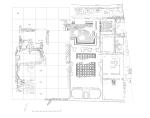Summary (English)
Excavations during June and July 2005 took place in the western part of the thermal complex. Quadrants U 2, U 3 and U 4 are located where a tepidarium was. The northern side is directly connected with a caldarium and a praefurnium, and in addition it had a hypocaust heating system. Excavations in quadrants U 2 and U 3 were carried out only in the surface part, because of a recent stone floor, while quadrant U 4 was excavated entirely. All archaeological material was mixed with recent items. In general, very little archaeological material was found.
Nothing has been preserved from the mosaic floor. A similar situation was in other quadrants in the tepidarium excavated in previous years. All the layers of the suspensurae were broken, and the tegulae, which stood on the rounded pottery columns, were carried away. According to the preserved mosaic tesserae, it can be concluded that the floor was a black and white mosaic with geometric decoration, the pattern was certainly very similar to the one preserved in the eastern parts of the baths. A smaller number of fragments of tubuli was found. In the eastern wall of the tepidarium there was a square niche, like the one on the western wall. One semi-circular and one more square niche will certainly appear in the eastern wall. The uncovered part of the wall shows a good quality of masonry with precisely carved stone blocks connected with high-quality mortar. It was preserved at a height of 30-60 cm.Quadrant T 8 is located north of the praefurnium. In its western part, a wall (height 0.5 m) was found, built of carved stone blocks, bound with mortar. On the inner surface, small remains of frescoes have been preserved (red on white background). Among the finds, there is a lot of pottery fragments, mostly tegulae, followed by bone, bronze and especially glass items; bronze stylus is particularly interesting. They can be dated from the 1st to the 3rd century. Interesting find is a large amount of marble slabs. After the fragments were washed, four types of marble were distinguished. It is not possible to determine the purpose of that space because it was excavated in a smaller part.
Quadrant S 9 is also north of the praefurnium, located along the outer northwest face of the baths. It was assumed that there was a street along that wall that flanked the baths on the north side. These excavations did not proof the existence of stones that would be the continuation of the street. In the eastern part of the quadrant, a continuation of wall 41 was found, 1 m long, 20-50 cm high. It is preserved only in the foundations and turns towards the west, which indicates the possibility that the thermal complex also extended further. Among the finds, pottery, mostly very fragmented tegulae, and bronze and glass items predominate (Boris Čargo 2006, Hrvatski arheološki godišnjak 2/2005, 353–355).
- Boris Čargo - Arheološki muzej u Splitu
Director
- Boris Čargo - Arheološki muzej u Splitu
Team
- Borko Vješnica
Research Body
- Arheološki muzej u Splitu
Funding Body
- Ministarstvo kulture Republike Hrvatske






![Download [PDF]](/excavation/skins/fasti/images/results/download_sml.png)
